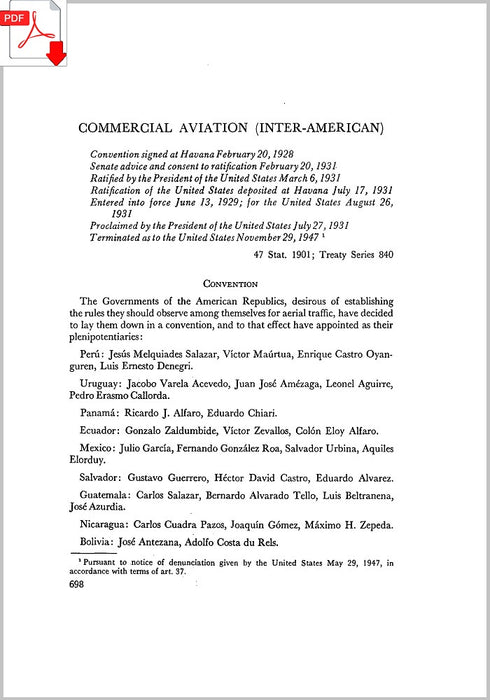
Habana 1928 - Convention on Inter-American Commercial Aviation (ebook)
Habana 1928 - Convention on Inter-American Commercial Aviation
Because of the US refusal to join the League of Nations, the rules of the Paris Convention did not apply to the Americas. This left a need for a separate form of international cooperation on a regional American basis.
The Habana Convention on Commercial Aviation was one of several conventions adopted at Habana on February 20,1928, by the delegates to the Sixth International Conference of American States.
The Havana Convention was modeled after the Paris Convention and it applied exclusively to private aircraft. Government aircraft were not included.
The convention includes provisions relating to marking of aircraft, landing facilities, prohibited transport, competency of flying personnel, registration of aircraft, prohibited areas and the rights of each state to prescribe the route to be followed over its territory by the aircraft of other States. The convention was designed to meet conditions existing in the Western Hemisphere for aerial navigation. Provisions to bring about uniformity in laws and regulations regarding aerial navigation are included.
The states obligate themselves to cooperate in
(a) the centralizing and distribution of meteorological information;
(b) the publication of uniform aeronautical charts, as well as the establishment of a uniform system of signals;
(c) the use of radiotelegraph in aerial navigation, establishment of the necessary radiotelegraph stations and the observance of the inter-American and international radiotelegraph regulations.
Th states will aim to uniformity of laws and regulations governing aerial navigation.
It recognized that every State had complete and exclusive sovereignty over the airspace above its territory and adjacent territorial waters. Each contracting state undertakes in time of peace to grant freedom of innocent passage above its territory to the private aircraft of other contracting states. However, each of the contracting states retains the right to prohibit, for public interest, flights by aircraft of other contracting states over fixed zones of its territory, with no distinction being made in this respect between its own commercial aircraft and those of other contracting states.
This convention provided a legal basis for the business development of US airlines throught North and South America in the 1930's. Clauses enabled U.S. owned airlines to freely operate services within North and South America. Commercial aircraft shall be permitted to discharge or take on at different airports in a contracting state passengers or cargo from or destined to points beyond the borders of such state. However, each contracting state retains the right to establish reservations and restrictions in favor of its own national aircraft in regard to the commercial transportation of passengers and merchandise within its territory.
Each State shall provide the Union with data on various subjects such as nationality marks, registrations and cancellations of registration of aircraft, regulations governing the rating of aircraft as to airworthiness, and restrictions in regard to prohibited transport.
12 pages - in English


